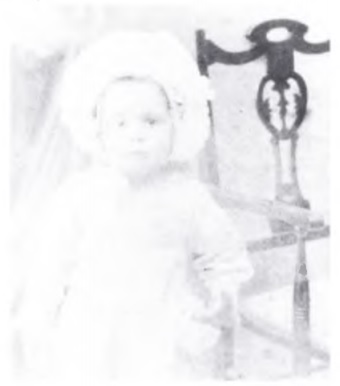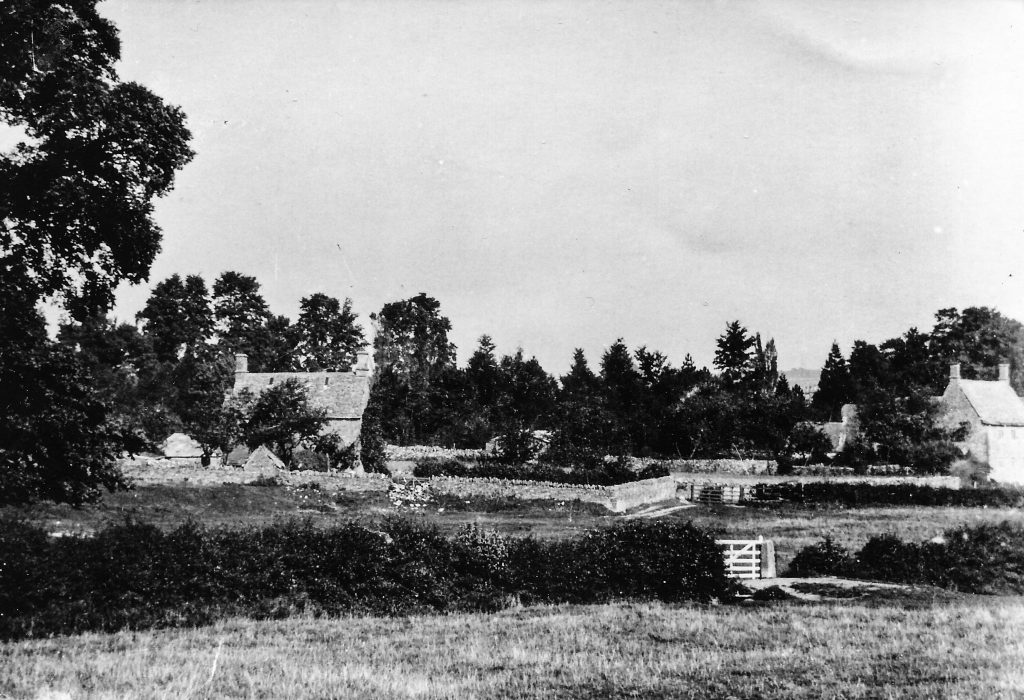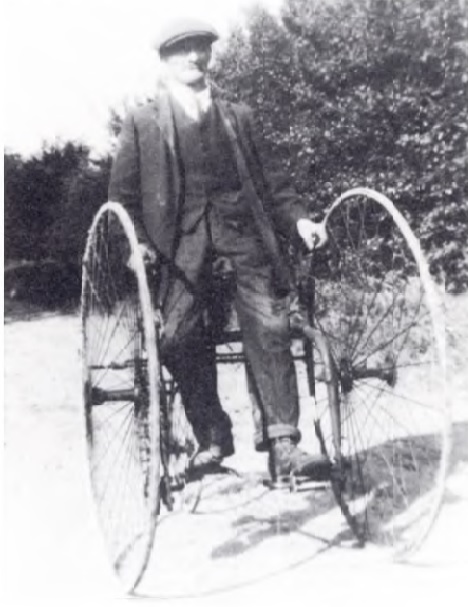This article was by Olive Barnes, later Mrs Olive Frost, who was born in The Square, Milton under Wychwood in 1907 and later lived in Calais Cottage, Frog Lane. It is taken from the society’s Journal No 6. It is also available as a PDF here.
My Mother rented three cottages which stood apart because, as she said, she wouldn’t have other peoples’ noise and stinks. In 1914 we moved to the last house in Frogmore Lane, which had a drive and stood in an acre of ground. My Mother Lizzy Barnes, formerly Lizzy Norgrove of Shipton, was a very clean and hard-working woman, very well-known and respected. She married Henry Barnes in Milton Church in 1888. She refused to use the work ‘obey’ in the marriage service and said instead ‘to love honour and nobay’.

Until 1910 we were quite well off; I remember my Father dropping sovereigns through his fingers intd my Mother’s lap. Groves’ men did contract work at that time. (I am delighted that Dad’s photograph is on page twenty-six of the Wychwoods Album; he is on the extreme right front.) He was very smart and good-looking and I adored him. In 1910 he met with a terrible accident. He went with other Groves’ men to dig gravel from a pit near the top of Milton High Street. They hadn’t been working long when the walls caved in and Dad was completely buried. His friend Percy Greenaway dug with his hands to find Dad’s face so that he could breathe. Dad never worked again and from then on we were very poor. Half his basic wage was paid to him weekly, amounting to 11. 3d. (56p).
Mother was very proud and although she had six children at school, not earning, she refused to allow the powers that were to put us into a home. She did all sorts of work to keep us fed and clothed. What wonderful people they all were, helping each other in ever)’ possible way, day and night. As we all nine grew up we became better off, and indeed our home was a palace.
The gardens were a joy to behold and it was usual to see people standing at the bottom o f the drive admiring the beauty. Mother would go to furniture sales at the big houses and buy beautiful furniture. She would bid against Marky Bunting, a well-known furniture dealer of Shipton. Mother always won. I still have a large mirror she bought at Shipton Court. The stories Dad told us on winter nights around a big fire, some handed down the generations, were a great joy to us children. Stories of local ghosts, highwaymen and murders; rather different to today’s television as our stories were all true.
When my Mother was eight years old she called at ‘The Lodge’ at Shipton and asked a lady if she would teach her to sew. ‘What a dear little girl’, said the lady, ‘ask your Mother if you can spend half an hour each afternoon and I will teach you to sew’. What a blessing that turned out to be. In our badly-off days Mother would buy clothes from rummage sales, given by the gentry, and reshape them into clothes for us. She made beautiful bedspreads for Mrs Samuda of Bruern Abbey who was very much looked up to.
My sister Dolly Barnes used to get smacks from my Mother because she refused to curtsey to Mrs Samuda. Dolly was a character and no mistake. She died in 1985 at the age of 88. Her real name was May Diamond jubilee because of her date of birth. I remember at her wedding, Molly Timms (later Mrs Jim Puddle) shouting ‘Good old Doll, keep your pecker up’, as my sister walked down the aisle of Milton Church on Dad’s arm. The whole village turned out for weddings and funerals then and we all went to church or chapel on Sundays. A very united village was Milton in those days.
Our house was known as Calais Cottage, pronounced Callis. The fields were First, Second and Third Callis. Dog Kennel Lane was so called because the Peppers of Shipton Court had kept dogs there. The cricket ground at Shipton was known as Shortcraft, the best cricket pitch in Oxfordshire. The fields nearby were called Diggerspit, Cow Common and Forty-eight Acres. Calais Cottage looking towards Frog Lane, Milton, before 1914 The paths through Bruern Wood were called the Vestry Light and Unkid Light.

When war broke out in 1914 the Milton men left their ploughs in the fields and went to join up. I remember standing outside the Baptist Chapel one Sunday afternoon watching young men sign their lives away. Some were only seventeen. There were 827 inhabitants in Milton at that time and we lost 48 of our lovely boys. Some also died later of their wounds.
Milton was a wonderful village in those days. Mr Guy Mayman was the tallest man in the village and Mr Dorset, the smallest man, worked for him. It was a common sight to see Mr Mayman being driven about in his pony and tub by Mr ‘Dosset’. The Maymans lived in Kohima, now Heath House. In the High Street lived old Mr Wright who had fought in the battle of Balaclava in 1855. Walking or running home I would pass the blacksmith’s and at the end of Jubilee Lane was the wheelwright’s where Mr Keen made lovely yellow wheels for tubs or traps. Roy Ridley was the carrier and I was often sent to Chipping Norton by carrier to collect goods Mother had ordered. We went through Churchill and the horse knew all the stops.
Our Vicar Mr Horlock was very much loved. As he lay dying, he said ‘Bury me near the organ so that I can hear it’. I was taken to see his corpse by Louie Pittaway of Shipton. I could never understand a word Mr Shildrick the curate said. When we sang the hymn Make mine eyelids close, I sang with much feeling thinking it meant a girl named Eyelid was needing clothes. Shipton had much loved vicars too: Mr Carter who christened me in Shipton Church in 1907, then Mr Nixon, a big man who went about on a bicycle and greeted everyone he met. People came from miles around to hear him preach. I was in Shipton Church when Miss Dee fell dead as she sang a hymn. They carried her body home on a hurdle. How sad we all were.
I knew Alfred Groves well; he was bent double with age, a nice-looking old gentleman with a stick. He used to put pears on the spiked railings for us children to find. Taking a short cut home from school through The Square, I would pass Renee Hedges’ house with her 13 cats. Her brother Jessie who had been a sailor lived with her and he wore his seaman’s hat until he died. There was no money for his funeral, so he was buried by the parish. The coffin was a cheap one and we could see his hair through the cracks. There was no one to follow him to the grave so kind Hilda Rathband said, ‘I’ll get my hat and follow the poor old b—’ and follow him she did

I remember her Mother always standing by the Methodist Chapel. We used to go to Tangley for picnics during the long summer holidays and one day we ventured down the tunnel that leads from Tangley Farm to Bruern Abbey. When we came upon a dead sheep, we beat a hasty retreat.
There is a chapel in this tunnel under Two Bush Hill, and Dad used to tell us of two poachers who had a smoke in it. I think part of this tunnel formed Granny Green’s cave on Chipping Norton Hill and then went on to Chadlington House. Our Mother took us to tea with Granny Green. Granny used to smoke a clay pipe, just like a man.
There was a beautiful beech tree over the cave. I asked her if she was nervous, living all alone up there and felt very humble when she answered, ‘My dear, the Good Lord looks after me’. As we used to whizz down Chipping Norton Hill on dark nights with our shopping, we would call out ‘Good night, Granny’ and she would answer ‘Good night my darlings, God bless you’. The hedges were aglow with glow-worms. A bygone age

